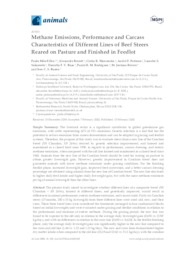Methane emissions, performance and carcass characteristics of different lines of beef steers reared on pasture and finished in feedlot.
Methane emissions, performance and carcass characteristics of different lines of beef steers reared on pasture and finished in feedlot.
Autoria: MÉO FILHO, P.; BERNDT, A.; MARCONDES, C. R.; PEDROSO, A. de F.; SAKAMOTO, L. S.; BOAS, D. F. V.; RODRIGUES, P. H. M.; RIVERO, M. J.; BUENO, I. C. S.
Resumo: The present study aimed to investigate whether different lines of a composite breed (5/8 Charolais × 3/8 Zebu), formed at different times, and genetically improved, would result in differences in animal performance, enteric methane emissions, and carcass traits. Forty?six Canchim steers (15 months, 280 ± 33 kg liveweight) from three different lines were used: old, new, and their cross. These three breed lines were considered the treatments (arranged in four randomized blocks based on initial liveweight) and were evaluated under grazing and feedlot conditions in relation to the performance and emission of enteric methane. During the grazing period, the new line was found to be superior to the old only in relation to the average daily liveweight gain (0.692 vs. 0.547 kg/day), and with no differences in relation to the cross line (0.692 vs. 0.620). In the feedlot finishing phase, only the average daily liveweight gain was significantly higher in the new line compared to the cross and old line (1.44 vs. 1.32 and 1.23 kg/day). The new and cross lines demonstrated higher dry matter intake when compared to the old line (10.25 and 10.42 vs. 9.11 kg/day), with the crossline Animals 2020, 10, 303 2 of 15 animals demonstrating the best feed conversion. The new line showed higher enteric methane emissions compared to the old line (178 vs. 156 g/day). The line had an effect on the carcass dressing of the animals, with greater fat thickness in carcasses from the new and cross lines than the old line (4.4 and 3.8 vs. 3.2 mm). Canchim cattle selected for improved productive performance characteristics does not guarantee animals with lower methane emissions under grazing conditions; while in feedlots, can lead to increased daily feed consumption, and hence, to higher emissions of methane.
Ano de publicação: 2020
Tipo de publicação: Artigo de periódico
Unidade: Embrapa Pecuária Sudeste
Observações
1 - Por padrão são exibidas publicações dos últimos 20 anos. Para encontrar publicações mais antigas, configure o filtro ano de publicação, colocando o ano a partir do qual você deseja encontrar publicações. O filtro está na coluna da esquerda na busca acima.
2 - Para ler algumas publicações da Embrapa (apenas as que estão em formato ePub), é necessário ter, no celular ou computador, um desses softwares gratuitos. Sistemas Android: Google Play Livros; IOS: iBooks; Windows e Linux: software Calibre.
Acesse outras publicações
Acesse a Base de Dados da Pesquisa Agropecuária (BDPA) para consultar o acervo completo das bibliotecas da Embrapa.

